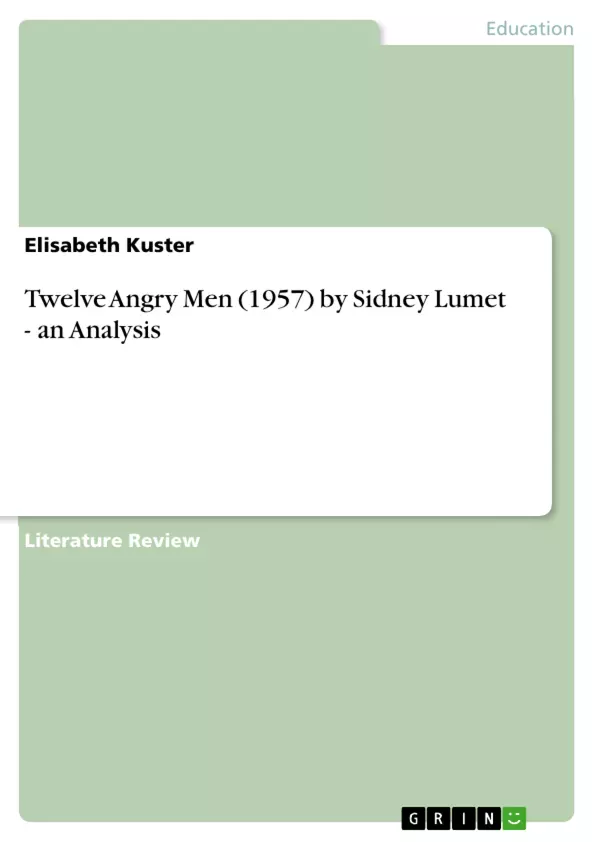In this paper I will look at the film Twelve Angry Men (1957) by Sidney Lumet. In short the film is about a criminal case in America in which a young Hispanic boy is accused of killing his father and the twelve members of the jury have to decide on his verdict. In this case “guilty” means death. After talking about the film in more detail I will also look at the jury system in America and discuss some of its most important aspects, e.g. jury selection, possible verdicts or the principle “Burden of Proof”. In doing so, I will raise questions on how fair the jury system really is and what its weaknesses or points of criticism might be. I will then also discuss the various roles and duties of jurors and I will include ethical problems they might be confronted with in their deliberations. Furthermore, the question if a jury is capable of reaching a fair and legally correct verdict will be discussed and being looked at from different perspectives. To conclude this paper I will show why the jury system, despite its controversial position, is still used and probably will never be abolished.
Table of Contents
- Introduction
- The film - Twelve Angry Men
- Plot
- Characters
- The Jury System in the USA
- Selection of Jury
- Role of the Jury During the Trial
- Burden of Proof
- The Verdict
- Jury Nullification
- Conclusion
Objectives and Key Themes
This paper examines Sidney Lumet's film, "Twelve Angry Men," analyzing the jury deliberation process within the context of the American legal system. It explores the fairness and potential weaknesses of the jury system, focusing on juror roles, ethical dilemmas, and the quest for a just verdict. The paper questions the system's capacity to deliver fair and legally sound outcomes.
- The American jury system and its processes
- Ethical considerations and challenges faced by jurors
- The influence of individual biases and prejudices on jury decisions
- Analysis of the power dynamics and group deliberation within the jury
- The concept of reasonable doubt and its role in reaching a verdict
Chapter Summaries
Introduction: This introductory chapter sets the stage for the analysis of Sidney Lumet's "Twelve Angry Men." It briefly outlines the film's plot, focusing on the jury's deliberation in a capital murder case where a young Hispanic boy is accused of patricide. The chapter introduces the paper's main objective: to critically examine the American jury system by analyzing its strengths, weaknesses, and the ethical dilemmas jurors face. It previews the discussion of jury selection, potential verdicts, the burden of proof, and the overall fairness of the system.
The Film - Twelve Angry Men: This chapter delves into a detailed account of "Twelve Angry Men," focusing on its plot and characters. The plot summary meticulously follows the jury's deliberation process, highlighting the initial near-unanimous "guilty" verdict and the gradual shift towards "not guilty" as Juror 8 systematically challenges the evidence and exposes the prejudices of his fellow jurors. The section on characters provides in-depth descriptions of each juror, analyzing their personalities, motivations, and the roles they play in the unfolding drama of the deliberation, showcasing a microcosm of societal biases and perspectives. The analysis underlines the film's impact and continued relevance, underscoring its socio-political themes.
Keywords
American jury system, Twelve Angry Men, jury deliberation, reasonable doubt, ethical dilemmas, prejudice, bias, capital punishment, justice, verdict, fairness, legal system, group dynamics.
Frequently Asked Questions: Analysis of "Twelve Angry Men" and the American Jury System
What is the overall purpose of this document?
This document provides a comprehensive overview of an academic analysis of Sidney Lumet's film "Twelve Angry Men," examining the American jury system through the lens of the film's plot and characters. It explores the strengths and weaknesses of the system, focusing on ethical considerations, biases, and the quest for a just verdict.
What topics are covered in the analysis?
The analysis covers the American jury system's processes (jury selection, roles during trial, burden of proof, and verdicts, including jury nullification), ethical challenges faced by jurors, the impact of individual biases and prejudices, power dynamics within jury deliberations, and the concept of reasonable doubt.
What is the structure of the document?
The document is structured with a table of contents, an overview of the objectives and key themes, chapter summaries, and a list of keywords. It begins with an introduction setting the context, followed by a detailed analysis of the film "Twelve Angry Men," including its plot and characters. The analysis then delves into the workings of the American jury system, concluding with a summary of findings.
How does the document analyze "Twelve Angry Men"?
The analysis of "Twelve Angry Men" focuses on the film's plot, meticulously tracing the jury's deliberation process. It also provides in-depth character descriptions, examining their personalities, motivations, and roles in the deliberation. The analysis highlights how the film showcases societal biases and the challenges of achieving a just verdict.
What are the key themes explored in the analysis?
Key themes include the fairness and potential weaknesses of the jury system, ethical dilemmas faced by jurors, the influence of biases and prejudices on jury decisions, power dynamics and group deliberation within the jury, and the crucial role of reasonable doubt in reaching a verdict.
What are the key takeaways or conclusions of the analysis?
The analysis critically examines the American jury system's capacity to deliver fair and legally sound outcomes. It highlights the complexities of jury deliberation, the potential for biases to influence verdicts, and the importance of considering ethical considerations in the pursuit of justice.
What are the keywords associated with this analysis?
Keywords include: American jury system, Twelve Angry Men, jury deliberation, reasonable doubt, ethical dilemmas, prejudice, bias, capital punishment, justice, verdict, fairness, legal system, group dynamics.
- Arbeit zitieren
- Mag. BSc Elisabeth Kuster (Autor:in), 2007, Twelve Angry Men (1957) by Sidney Lumet - an Analysis, München, GRIN Verlag, https://www.grin.com/document/182968



